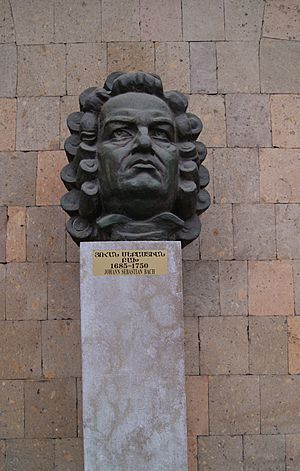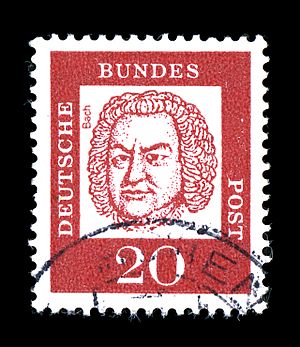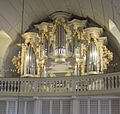Johann Sebastian Bach facts for kids
Quick facts for kids
Johann Sebastian Bach
|
|
|---|---|

Portrait of Bach, aged 61, by E. G. Haussmann, 1748
|
|
| Born | 21 March 1685 (O.S.) 31 March 1685 (N.S.) |
| Died | 28 July 1750 (aged 65) |
|
Works
|
List of compositions |
| Signature | |
 |
|
Johann Sebastian Bach (31 March [O.S. 21 March] 1685 – 28 July 1750) was a very famous composer and musician. He lived during the Baroque period, which was a time when music was often grand and decorative. Bach was born in a place called the Duchy of Saxe-Eisenach.
He is known for many amazing pieces of music. Some of his most famous instrumental works include the Brandenburg Concertos and the Goldberg Variations. He also wrote beautiful vocal music, like the St Matthew Passion and the Mass in B minor. Since the 1800s, many people have thought of Bach as one of the greatest composers ever.
Contents
Bach's Life and Music
Johann Sebastian Bach came from a family full of musicians. His father, Johann Ambrosius Bach, was a musician who worked for a duke. Many of his relatives were also professional musicians. They played instruments like the violin and the organ. Some were church music directors called Cantors, and others directed music at royal courts, known as Kapellmeisters. Most of them could play several instruments.
Bach himself had many children, and several of them became famous composers too. These included Carl Philipp Emanuel Bach, Johann Christian Bach, Johann Christoph Friedrich Bach, and Wilhelm Friedemann Bach.
Early Career as an Organist
Bach became an organist for the Duke of Saxe-Weimar. The Duke had a chapel with an organ, and Bach wrote many of his great organ pieces there. He became very well-known for his organ playing. People invited him to play in large churches and to give advice on how to build organs. He was also incredibly good at making up music on the spot, which is called improvisation.
In 1714, the Duke gave Bach a new job as Konzertmeister, which paid more money. This job meant he had to write cantatas, which are pieces of music for church services.
Moving to Cöthen
In 1717, Bach was offered an even better job in the town of Cöthen. The Duke in Weimar was not happy about this and did not want Bach to leave. Bach insisted on going, so the Duke actually held him back for about a month. In the end, the Duke had to let him go.
In Cöthen, Bach worked for Prince Leopold. The Prince loved music and was a wonderful person to work for. Bach was the Kapellmeister, or music director, and was treated very well. The organ in Cöthen was not very good, so Bach did not write much organ music during this time. However, the Prince had an orchestra, and Bach was in charge of it. Almost all of Bach's orchestral music was written while he was in Cöthen.
Later Life and Legacy
Bach wrote many fugues, which are complex musical pieces where different parts play the same melody at different times. He decided to put a collection of them together called The Art of Fugue. He planned to publish it, but he passed away before he could finish. His son later published it to honor his father. In the last year or two of his life, Bach became blind, even after having two eye operations.
Many years after Bach died, in the 1800s, more people became interested in his music. A lot of his works were published more than a hundred years after he was gone.
Bach's Music Today
Today, in the 21st century, Bach's music is very easy to find. You can listen to his compositions online, and even see copies of his original handwritten music. There are many websites just for him and his music.
When people talk about the best classical music, Bach's works are almost always included. For example, in one list of the best classical music recordings, Bach's music appeared more often than any other composer's. This shows how important and loved his music still is.
Bach's Burial Place
Bach was first buried in a cemetery in Leipzig. His grave was not marked for nearly 150 years. In 1894, his remains were found and moved to a vault in St. John's Church. This church was destroyed during World War II. So, in 1950, Bach's remains were moved again to their current resting place in St. Thomas Church.
Recognition in Churches
Some Protestant churches remember Bach each year. The Episcopal Church and the Lutheran Church both celebrate him on July 28th. This day is a special feast day to honor his contributions to church music.
Images for kids
-
Johann Ambrosius Bach, 1685, Bach's father. Painting attributed to Johann David Herlicius
-
St. Thomas Church and School, Leipzig in 1723
-
Bach's guide on ornaments as contained in the Klavierbüchlein für Wilhelm Friedemann Bach
See also
 In Spanish: Johann Sebastian Bach para niños
In Spanish: Johann Sebastian Bach para niños












